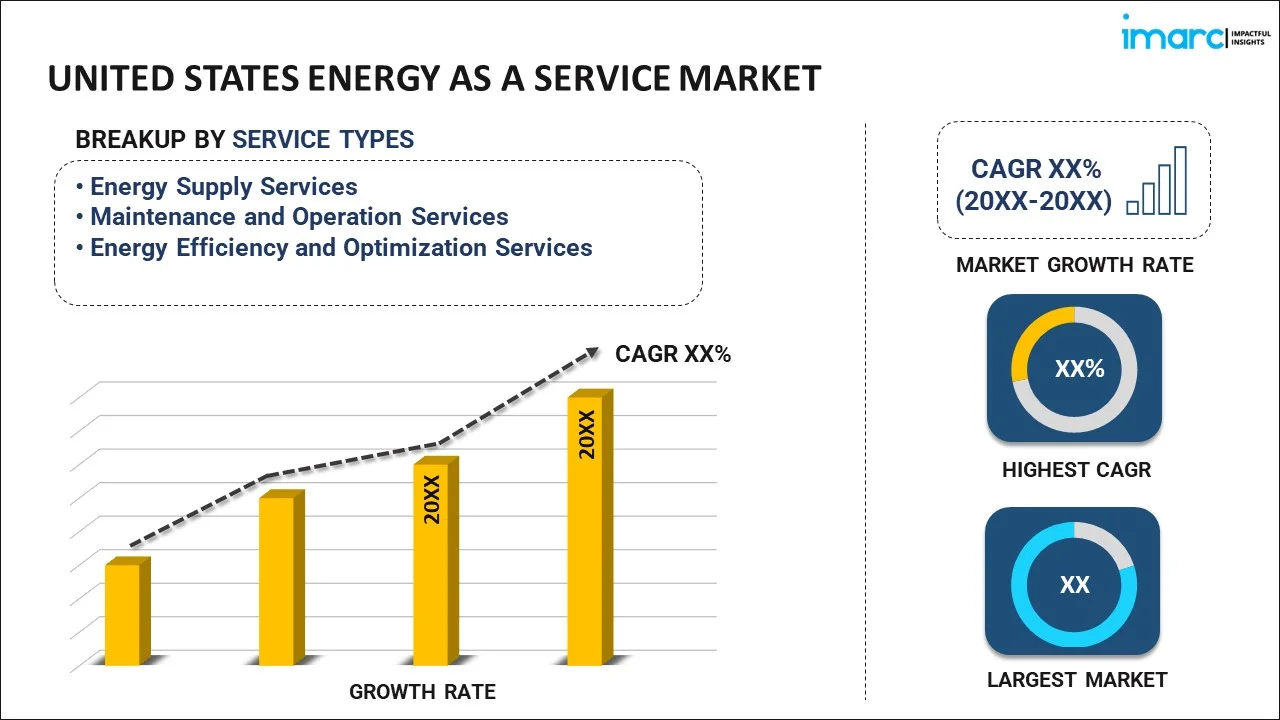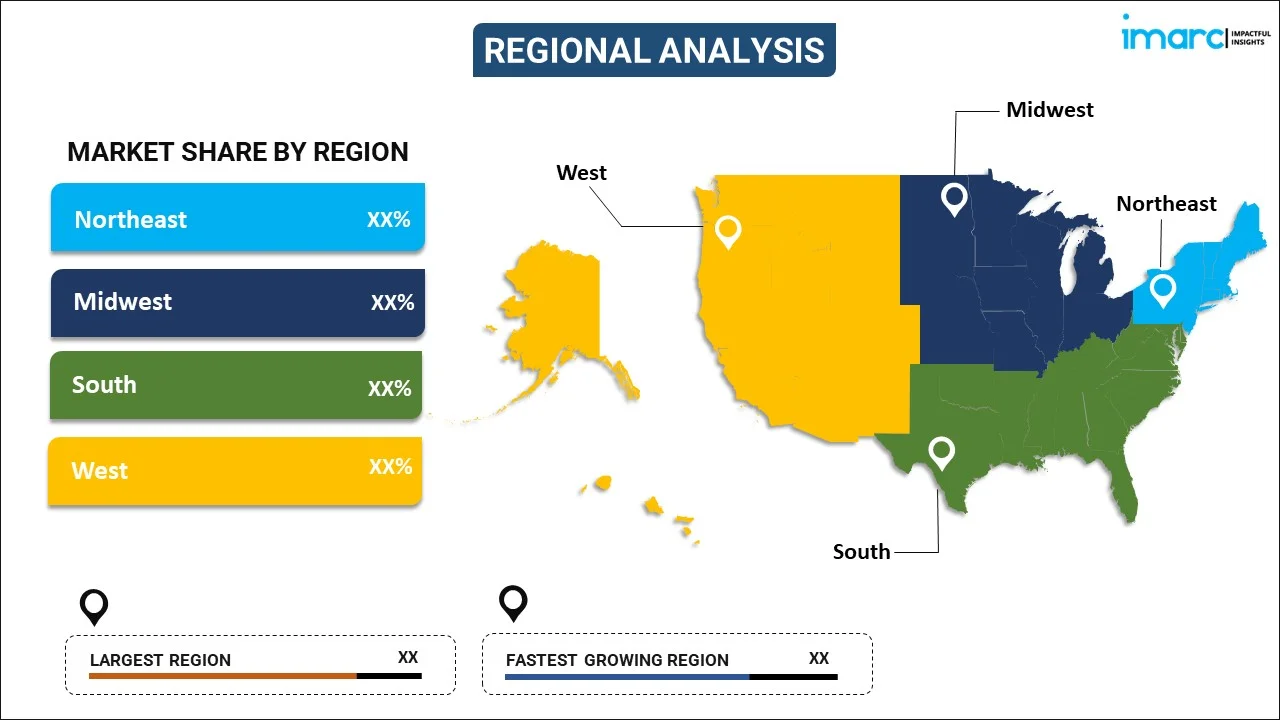
United States Energy as a Service Market Report by Service Type (Energy Supply Services, Maintenance and Operation Services, Energy Efficiency and Optimization Services), End User (Commercial, Industrial), and Region 2025-2033
Market Overview:
United States energy as a service market size reached USD 18,930.4 Million in 2024. Looking forward, IMARC Group expects the market to reach USD 48,280.4 Million by 2033, exhibiting a growth rate (CAGR) of 10.96% during 2025-2033. The growing emphasis on sustainability and environmental responsibility, continuous advancements in technology, and the increasing frequency and severity of climate-related events, such as hurricanes, wildfires, and extreme weather conditions, represent some of the key factors driving the market.
|
Report Attribute
|
Key Statistics
|
|---|---|
|
Base Year
|
2024 |
|
Forecast Years
|
2025-2033
|
|
Historical Years
|
2019-2024
|
| Market Size in 2024 | USD 18,930.4 Million |
| Market Forecast in 2033 | USD 48,280.4 Million |
| Market Growth Rate (2025-2033) | 10.96% |
Energy as a service (EaaS) is a comprehensive energy management approach that provides businesses and organizations with a turnkey solution for their energy needs. It involves the delegation of energy management tasks to a specialized service provider, relieving clients of the burden of handling complex energy systems. It leverages cutting-edge technologies, such as the Internet of Things (IoT) sensors, data analytics, and renewable energy sources to maximize energy efficiency. It can lead to significant cost reductions through improved energy efficiency and optimized energy procurement. It promotes the use of renewable energy sources, helping organizations reduce their carbon footprint and meet sustainability goals. It is widely used in commercial real estate to optimize energy consumption in office buildings, shopping malls, and hotels. It is also utilized by manufacturers to enhance energy efficiency in factories and production facilities, reducing operational costs. Moreover, it is employed in the healthcare industry to ensure an uninterrupted energy supply for critical medical equipment. Besides this, as it helps reduce risks associated with energy market fluctuations, regulatory changes, and equipment maintenance, the demand for EaaS is increasing in the United States.
United States Energy as a Service Market Trends:
The increasing emphasis on sustainability and environmental responsibility in the United States represents one of the primary factors propelling the market growth. Businesses across various industries in the country are focusing on reducing their carbon footprint and embracing renewable energy sources. EaaS providers offer solutions that enable organizations to transition to cleaner and more sustainable energy options, aligning with their environmental goals. Apart from this, continuous advancements in technology, especially in the Internet of Things (IoT) and data analytics, are enhancing the capabilities of EaaS providers. IoT sensors and smart meters enable real-time monitoring and control of energy consumption, and data analytics offer valuable insights for optimizing energy usage. These technological innovations drive the adoption of EaaS as a modern and data-driven approach to energy management. Furthermore, governing authorities in the country are increasingly investing in renewable energy initiatives and energy efficiency measures. They are offering incentives, tax credits, and regulatory frameworks to promote the adoption of clean energy solutions. In line with this, the increasing frequency and severity of climate-related events, such as hurricanes, wildfires, and extreme weather conditions, is creating a positive outlook for the market. Besides this, the rising shift toward remote work and distributed workforces and the increasing number of employees working from various locations, including home offices, are influencing the market positively. EaaS providers offer remote monitoring and control capabilities, allowing businesses to optimize energy consumption across multiple locations.
United States Energy as a Service Market Segmentation:
IMARC Group provides an analysis of the key trends in each segment of the market, along with forecasts at the country level for 2025-2033. Our report has categorized the market based on service type and end user.
Service Type Insights:

- Energy Supply Services
- Maintenance and Operation Services
- Energy Efficiency and Optimization Services
The report has provided a detailed breakup and analysis of the market based on the service type. This includes energy supply services, maintenance and operation services, and energy efficiency and optimization services.
End User Insights:
- Commercial
- Industrial
A detailed breakup and analysis of the market based on the end user have also been provided in the report. This includes commercial and industrial.
Regional Insights:

- Northeast
- Midwest
- South
- West
The report has also provided a comprehensive analysis of all the major regional markets, which include the Northeast, Midwest, South, and West.
Competitive Landscape:
The market research report has also provided a comprehensive analysis of the competitive landscape. Competitive analysis such as market structure, key player positioning, top winning strategies, competitive dashboard, and company evaluation quadrant has been covered in the report. Also, detailed profiles of all major companies have been provided.
United States Energy as a Service Market Report Coverage:
| Report Features | Details |
|---|---|
| Base Year of the Analysis | 2024 |
| Historical Period | 2019-2024 |
| Forecast Period | 2025-2033 |
| Units | Million USD |
| Scope of the Report | Exploration of Historical and Forecast Trends, Industry Catalysts and Challenges, Segment-Wise Historical and Predictive Market Assessment:
|
| Service Types Covered | Energy Supply Services, Maintenance and Operation Services, Energy Efficiency and Optimization Services |
| End Users Covered | Commercial, Industrial |
| Regions Covered | Northeast, Midwest, South, West |
| Customization Scope | 10% Free Customization |
|
Post-Sale Analyst Support |
10-12 Weeks |
| Delivery Format | PDF and Excel through Email (We can also provide the editable version of the report in PPT/Word format on special request) |
Key Questions Answered in This Report:
- How has the United States energy as a service market performed so far and how will it perform in the coming years?
- What has been the impact of COVID-19 on the United States energy as a service market?
- What is the breakup of the United States energy as a service market on the basis of service type?
- What is the breakup of the United States energy as a service market on the basis of end user?
- What are the various stages in the value chain of the United States energy as a service market?
- What are the key driving factors and challenges in the United States energy as a service?
- What is the structure of the United States energy as a service market and who are the key players?
- What is the degree of competition in the United States energy as a service market?
Key Benefits for Stakeholders:
- IMARC’s industry report offers a comprehensive quantitative analysis of various market segments, historical and current market trends, market forecasts, and dynamics of the United States energy as a service market from 2019-2033.
- The research report provides the latest information on the market drivers, challenges, and opportunities in the United States energy as a service market.
- Porter's five forces analysis assist stakeholders in assessing the impact of new entrants, competitive rivalry, supplier power, buyer power, and the threat of substitution. It helps stakeholders to analyze the level of competition within the United States energy as a service industry and its attractiveness.
- Competitive landscape allows stakeholders to understand their competitive environment and provides an insight into the current positions of key players in the market.
Need more help?
- Speak to our experienced analysts for insights on the current market scenarios.
- Include additional segments and countries to customize the report as per your requirement.
- Gain an unparalleled competitive advantage in your domain by understanding how to utilize the report and positively impacting your operations and revenue.
- For further assistance, please connect with our analysts.
 Request Customization
Request Customization
 Speak to an Analyst
Speak to an Analyst
 Request Brochure
Request Brochure
 Inquire Before Buying
Inquire Before Buying




.webp)




.webp)












